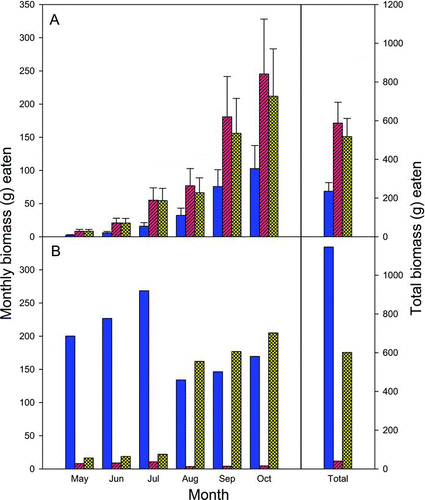Figures & data
FIGURE 1 Total length versus date of capture for the three red drum cohorts that were encountered during 2007–2009 sampling in the New River estuary, North Carolina. Dashed vertical lines denote the biological birthdate of 1 September. Daily ration estimation was completed during the May–October period of rapid growth.
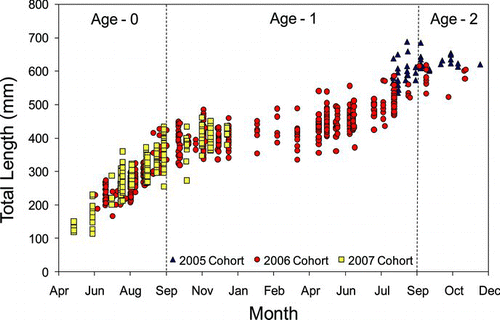
TABLE 1 Diet composition for two age-groups of red drum in the New River estuary, North Carolina, during 2007–2009 (%FO = percent frequency of occurrence of prey; %W = percent contribution of prey by weight). Prey items were identified to the species level whenever possible; otherwise, higher taxonomic levels (genus, family, or class) are indicated. The “other” prey category includes fishing lures, gravel, nylon rope, metal, and plant material (UID = unidentified).
TABLE 2 Interannual variation in diet composition (%FO = percent frequency of occurrence of prey; %W = percent contribution of prey by weight) for the two red drum age-groups sampled in the New River estuary. Diet information is examined for the four largest prey categories only and excludes several invertebrate prey of minor dietary importance (other bony fishes = all fish species except Atlantic menhaden; see Table 1).
FIGURE 2 Seasonal variation in red drum diet composition in the New River estuary: (A) percent frequency of occurrence (%FO) of prey for age-0–1 red drum; (B) percent contribution of prey by weight (%W) for age-0–1 predators; (C)%FO of prey for age-1–2 red drum; and (D)%W for age-1–2 predators. Diet information is included only for the four largest prey categories (Atl. menhaden = Atlantic menhaden) and excludes several invertebrate prey types of minor dietary importance. The %FO is normalized to 100% to facilitate comparison among seasons.
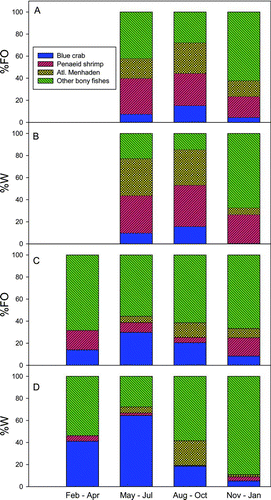
FIGURE 3 Mean (±SE) gut fullness (g of prey/g of predator) in red drum versus the number of hours past sunset during May–October in the New River estuary. Each symbol represents the mean gut fullness pooled across all dates for both age-groups (age-0–1 and age-1–2 red drum) within 2-h increments past sunset. The pattern is fitted using piecewise regression (P = 0.0011, R 2 = 0.781; constant = 0.25; segment 1 slope = −0.0013; segment 2 slope = not significant; breakpoint = 13 h past sunset).
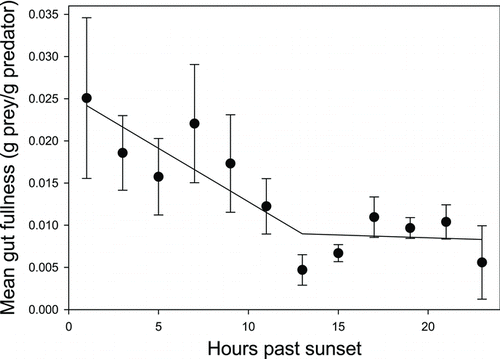
FIGURE 4 Mean (±SE) gut fullness (g of prey/g of predator) in age-0–1 red drum versus time of capture (beginning at 2000 hours [8:00 PM] in each panel) during (A) July 2007, (B) August 2007, (C) October 2007, (D) November 2007, (E) July 2008, and (F) August 2008, representing dates when declining gut fullness patterns allowed estimation of gastric evacuation rates (see ). Each symbol represents the mean gut fullness per net set. Absence of error bars indicates that only one fish was captured in a given net set. Note the slight changes in scale among y-axes. For age-1–2 red drum, the evacuation rate could be estimated during only one time period (May 2008); the decline in gut fullness for those fish is presented as an inset in panel E.
![FIGURE 4 Mean (±SE) gut fullness (g of prey/g of predator) in age-0–1 red drum versus time of capture (beginning at 2000 hours [8:00 PM] in each panel) during (A) July 2007, (B) August 2007, (C) October 2007, (D) November 2007, (E) July 2008, and (F) August 2008, representing dates when declining gut fullness patterns allowed estimation of gastric evacuation rates (see Table 3). Each symbol represents the mean gut fullness per net set. Absence of error bars indicates that only one fish was captured in a given net set. Note the slight changes in scale among y-axes. For age-1–2 red drum, the evacuation rate could be estimated during only one time period (May 2008); the decline in gut fullness for those fish is presented as an inset in panel E.](/cms/asset/e56554c4-e072-442b-80fd-22cc20d1d328/umcf_a_699018_o_f0004g.gif)
TABLE 3 Estimates of gut fullness, instantaneous gastric evacuation rate (G), and daily ration for red drum by age-group during each diel sampling event (Temp = daily mean water temperature; n = number of red drum captured). Gut fullness is the mean (maximum observed in parentheses) for all fish captured during each sampling event; G was calculated using the mean gut fullness values for each independent net set during a sampling event. Daily ration is expressed as grams of prey per gram of predator per day. Empty cells (–) represent dates when gut fullness data were insufficient to estimate G
FIGURE 5 Prey sizes eaten versus total length (TL) of red drum for the four major prey categories (Atl. menhaden = Atlantic menhaden). The solid line indicates mean prey size estimated based on least-squares regression; dashed lines represent the estimated upper (95th percentile) and lower (5th percentile) bounds of the distribution based on quantile (least absolute deviation) regression (Scharf et al. Citation1998).
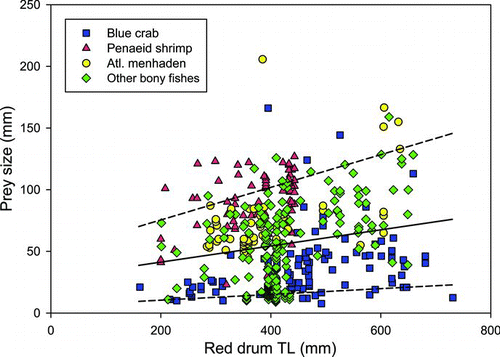
FIGURE 6 Estimated biomass of prey eaten by a single red drum in the New River estuary during each month (May–October), as calculated from field estimates of daily ration and diet composition: (A) biomass consumed by an age-0–1 fish; and (B) biomass consumed by an age-1–2 fish. Calculations were made for three major prey types (blue crabs, penaeid shrimp, and Atlantic menhaden). Total biomass eaten by a single red drum during the entire 6-month period is illustrated at the far right of each panel (secondary y-axis). Error bars (+SD) were calculated for each prey type and month by using the observed SD for red drum daily ration. No error bars are shown for age-1–2 red drum since only one estimate of daily ration was available. The SDs for estimates of total biomass eaten were calculated after first pooling the variance estimates for each month.
